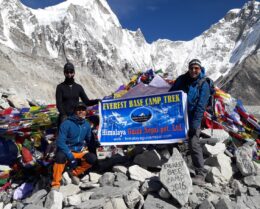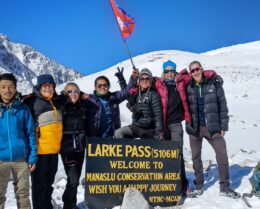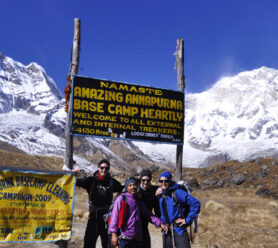Gokyo Ri Trek Difficulty
UPDATED ON 3 February, 2023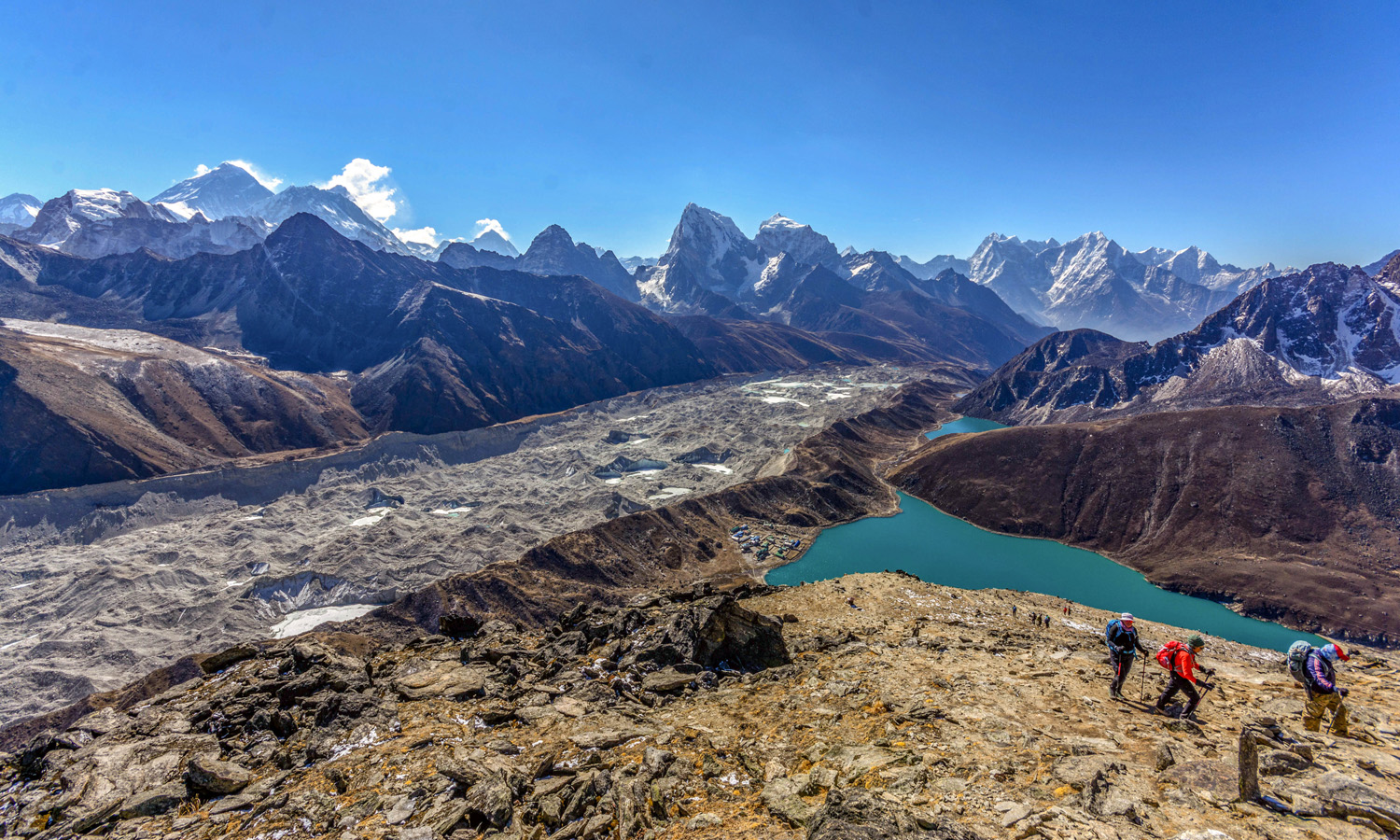
The Everest Gokyo Ri trek is spectacular in Nepal’s Everest region. However, to properly plan this trek and reap its benefits, you must be knowledgeable about the Everest Gokyo Ri Trek difficulty.
One of the longest trekking routes is the Everest Gokyo Ri trek. The difficulty level of this trek is high. You must walk on varied terrains for about 6-7 hours each day while on this journey. 10 days of the Trek will involve traveling and lodging at elevations greater than 12,000 feet.
You will ascend to a height of more than 17,000 feet four times throughout this trek. They can be found at the Kala Patthar, Cho La Pass, Everest Base Camp, and the peak of Gokyo Ri. This journey is quite challenging because of the altitude and the long days. When the air is thinner, breathing may be difficult, making trekking a challenge.
The trek to Everest Base Camp is probably well-known to most people and is on the bucket lists of many. However, this trail offers more diversity thanks to the stunning Everest vistas from Gokyo Ri’s summit.
Gokyo Trek
You will pass past five sparkling alpine lakes as you make your way along this route. At Gokyo, the beautiful Mt. Cho Oyu then stands directly in front of you. And that isn’t all. Look up while standing atop Gokyo Ri at 17,500 feet to see the three eight-thousander mountains in the world: Everest, Lhotse, and Makalu.
The Ngozumpa glacier, the longest glacier in the Himalayas, may be seen if you look down. Well, this is just the Gokyo side; the Everest side contains much more. It’s safe to state that you are benefiting from both trials.
However, one should be aware of the different obstacles and hardships that await before embarking on this trek. Being healthy and physically fit is essential. Since you’ll be walking for hours each day, it can occasionally become stressful and exhausting. The high altitude is also a factor.
Therefore, it is ideal and sensible to engage in physical preparation before the trek. Additionally, you should possess the commitment and willpower necessary to meet any task that comes your way.
Mount Everest
The process of ascending Mount Everest has seen a significant alteration in the years since the first person did so in 1953. Thanks to advancements in knowledge, technology, and the substantial infrastructure supplied by professionally guided excursions, hundreds of mountaineers now successfully complete the feat each year for those willing to face the hazards and a steep price tag
Where is Mount Everest
At the tip of the Himalayan Mountain range, Mount Everest, also known in Nepali as Sagarmatha and in Tibetan as Chomolungma, crosses the border between Nepal and Tibet. The mountain is located quite close to the equator, at a latitude of around 28 degrees, even though climbing to the top of the globe is a difficult and perhaps deadly endeavor because of the peak’s tremendous altitude, avalanches, icefalls, and other dangers.
Factors determining the trek difficulty
Duration
The length of the Everest Gokyo Ri trek can be altered by choosing a different route. Depending on your preferences, you can choose the number of days.
Now, if you select a shorter package, you will have to change the acclimatization days, which means you will walk farther and for longer. It may be harsh to do so. That can make your hiking experience challenging.
Nevertheless, if you pick the lengthier bundle. You have enough time to allow your body to acclimatize to different elevations.
Weather and Temperature
The Everest Gokyo Ri trek’s difficulty greatly depends on the weather. In the mountains, the weather varies a lot. You will see a shift in the weather conditions every hour. And the unpredictable weather could make your trek more difficult.
The Everest Gokyo
By picking the right time to go on this excursion, you can avoid dealing with weather-related issues like chilly weather. The spring, around April, and the fall, around October, are the ideal seasons to go on the Everest Gokyo Ri trek.
In April, daily highs typically range from 15 to 12 degrees Celsius, while October highs are slightly lower. While at night it drops to between -5 and -10 degrees.
You’ll be able to see the mountains clearly during this time. In addition, the weather is nice and consistent in contrast to the winter, which can be quite cold and snowy.
Additionally, the trekking track is not slick, which is probably a problem when trekking during a monsoon. These are some of the explanations why thousands of trekkers like this season for their treks.
Altitude Sickness
Climbing to a high altitude is required for mountain trekking. Additionally, the risk of altitude sickness rises with elevation.
In the mountains, AMS (acute mountain sickness) is a frequent cause for concern. The oxygen content and atmospheric pressure decrease as you ascend higher. Breathing becomes challenging as a result.
One of the biggest challenges is your ability to adapt to high altitudes since you will frequently be above 5000 meters (16405 feet) during the walk. And everyone, regardless of age, gender, or degree of fitness, is susceptible to altitude sickness. So it’s difficult to say whether or not one is entirely secure.
In light of this, it is crucial to understand altitude sickness. Discover the early warning signs and symptoms so you can take the appropriate measures to stop the problem before it becomes worse.
It is best to stop and take the required break if you ever feel like you are experiencing AMS symptoms. While walking at a higher altitude, it is imperative to rest and acclimatize.
And your only choice is to descend if resting doesn’t help your condition. It is never a good idea to exert too much physical force. Even the fatal condition can result from doing this.
And your only choice is to descend if resting doesn’t help your condition. It is never a good idea to exert too much physical force. Even the fatal condition can result from doing this.
You can reduce your risk of getting altitude sickness by walking slowly, drinking plenty of water, and abstaining from alcohol, among other things. The most crucial step is acclimating.
Physical Stamina and Training
It might be demanding and difficult to walk up to elevations above 5000 meters on occasion, thus it is crucial to prepare well before the trek. It would be easier to navigate the paths if you are physically fit and have the required stamina for the walk.
Some of the fundamental workouts you may perform to get in shape for the trek are brisk walking, jogging, skipping, and climbing stairs.
Additionally, developing your strength is crucial. You will have to journey a great distance while carrying your backpacks at a high altitude. You must also navigate a rocky landscape. Leg fatigue may be a problem.
Your legs will benefit from being stronger as a result of this. Squats can be performed to strengthen them.
Flexibility is another factor that will make your travel more comfortable. You can help yourself with this by frequently stretching your hamstrings, quadriceps, hip flexors, lower back muscles, and shoulders.
Thus, by doing these activities, you can get in shape before your trek.
Some Measures to Cope with Altitude Sickness in Everest Gokyo Lake Trek
Trek gradually with a slow pace
While trekking in such high-altitude places, the essential mantra is to climb slowly and steadily. With good acclimatization and a rest day after every 3,000 feet of elevation, you should only ascend 600 feet every day. If you adhere to these instructions, altitude sickness is something you can manage with ease.
Increase your food and water intake
Because your body burns calories more quickly at higher altitudes, you must also consume more calories. You ought to consume a lot of complete grains along with several healthful foods. In addition, you need to keep your body hydrated. Keeping hydrated also aids in preventing and treating altitude sickness.
Consult a physician and take medication
Before setting off on your journey, see a doctor. Avoid attempting to self-medicate because it could cause problems. Inform your guide right away and, if your doctor recommends it, take Diamox or other anti-nausea medication.
Highlights of Gokyo Lake Trek
- Visit the lakes with turquoise water.
- Walk until Gokyo Ri
- A lovely vista of Mount Everest
- Exciting flight to the airport in Lukla
- Take a trip to Sagarmatha National Park.
- Forest trails lined with distinctive flora and animals
- Amazing vista of further snow-capped peaks
- Investigate Namche Bazaar.
- Visit a museum with historical artifacts.
Major Attraction of the Everest Region
Namche Bazar
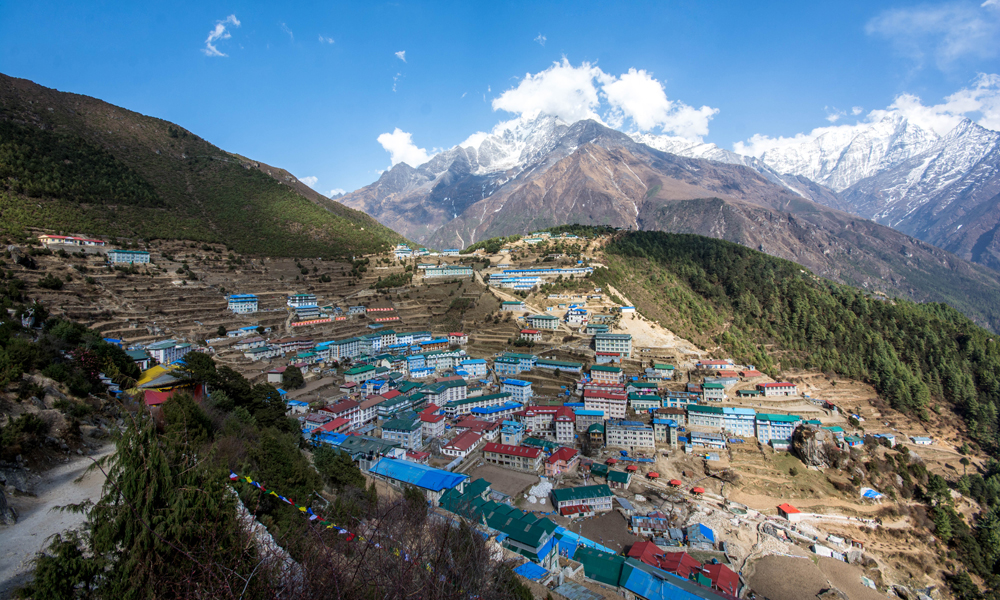
The entrance to the High and Mighty Himalayas is popularly known as Namche Bazaar. This Sherpa community is a well-liked stop for tourists making the Everest Trek. After performing the appropriate acclimatization steps, the traveler travels to a different destination after multiple routes depart from this location. You can reach this lively metropolis from Lukla after a few hours of trekking. Despite being located in a rural place and not being reachable by road, Namche Bazaar offers similar services and products as Thamel. It is regarded as Nepal’s second Thamel. Hotels, inns, cafes, and restaurants come in all shapes and sizes. You can simply find equipment for trekking and mountaineering if you wish to buy it.
Sagarmatha National Park
The first natural World Heritage Site in Nepal, Sagarmatha National Park, was created in 1976. Later, in 1979, UNESCO declared it to be a Natural World Heritage Site. This national park continues to work with the goals of conserving the forest, wildlife, and cultural resources. Later, they began focusing on the protection of natural energy and the search for alternative sources of energy. Nearly the entire terrain is made up of arid regions, enormous boulders, high slopes, and little flora. In the national park, you can see species like Himalayan Thar, musk deer, ghoral, and Himalayan black bear. The majority of the vegetation is made up of fir, rhododendron, birch, and juniper trees.
Gokyo lake
Gokyo Lakes are oligotrophic lakes located in Nepal’s Khumbu Region at an elevation of 4700-5000 meters. The area, which has the highest concentration of fresh water in the world, has a total of six lakes. Thonak Lake is the largest lake out of all the lakes, and Gokyo Cho is the main river, with Gokyo lying on its eastern coast. Gyazumpa Lake, Tanjung Cho, and Ngozumpa Cho are the additional lakes. The majority of the water gathered at the lakes comes from the seepage of glacial lakes, of which the Ngozumpa glacier is one.
Both Hindus and Buddhists regard the Gokyo Lakes as holy. The Hindus who participate in the occasion take a deep swim in the lake to receive blessings. They hold that everyone reveres the Snake God, who they think sits at the lake’s bottom. These lakes are associated with Vishnu and Shiva, and it is thought that they have been protecting this area for a very long time.
Kalapathar – EBC
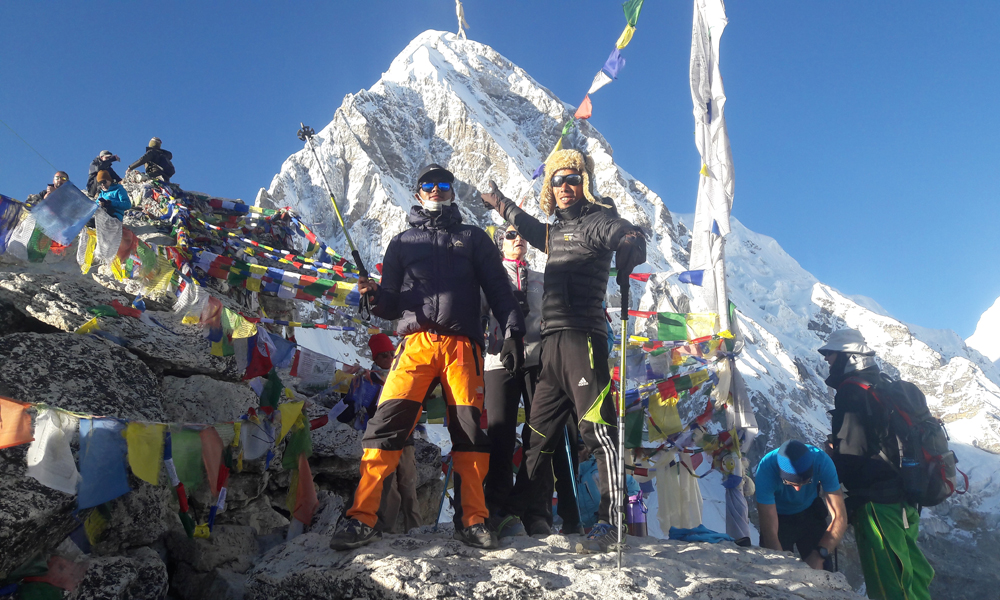
At Kalapatther’s summit, prayer flags fly against the power of the wind. The world’s tallest mountain, Mount Everest, is best viewed from the summit. It is impossible to see Everest’s summit region from the base camp. It takes a lot of time for trekkers to reach the peak in order to see Mount Everest, Lhotse, Nuptse, Changtse, and the Khumbu glacier.
Everest View Hotel
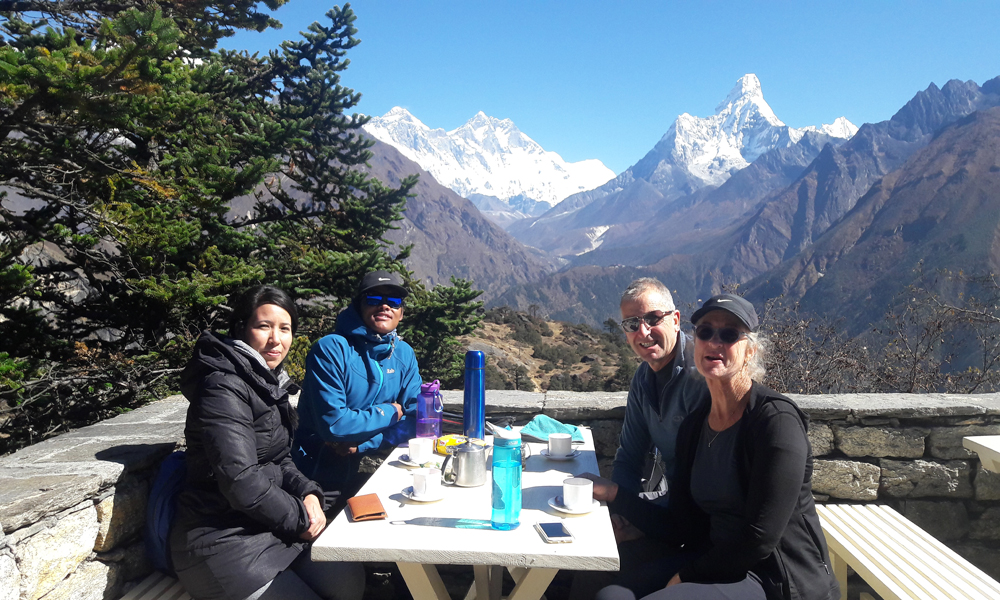
The impressive Hotel Everest View was constructed upon a 3880m ridge in the Everest region. The established hotel was finished over a number of years, and it opened its doors in 1971. It was nearly impossible to construct such a building during those years, but when working hands came together, the dreams and efforts became a reality.
This exquisite and understated work of art is praised by people all over the world. The hotel creates a serene and dynamic environment by blending its existence with the surrounding natural landscape. There are 12 rooms, each of which is configured to provide a panoramic view of Mount Everest in addition to other sights.
The hotel provides a 360-degree panorama of the Himalayas, where Mt. Everest dominates everything. The hotel has the best dining options and the most stunning Himalayan views. It will be an experience of a lifetime to see the vista from the fantastic wonderful position. You will remember those views for the rest of your life.
Trekkers traveling to the Everest region on foot or those taking a mountain ride by helicopter are welcome to stop by the hotel and have a wonderful dining experience. The hotel provides excellent service and can accommodate 50 people on the terrace and 30 people in the dining room at once.
Tips to Overcome Gokyo Ri Lake Trek Difficulty
Stay Hydrated
This trek will require you to walk continuously for 5 to 6 hours, which increases your risk of becoming dehydrated. Consequently, you must trek with a refillable bottle.
Always fill your bottle before starting your walk because you might not see any stores for a while. A body that is well hydrated is also essential to preventing altitude sickness.
The lodge where you will be staying will allow you to refill your bottle with hot water. However, there can be an additional fee for it. Additionally, always keep a water purification tablet with you to use if you are unsure of the location of a water source.
Physical Exercise
Both physical activity and meditation can help you maintain mental peace and boost your body’s endurance. Before beginning a trek in high terrain, it is important to have a healthy physique and a cheerful outlook.
You can exercise on your own by doing things like cycling, running, short treks, daily walks of three to four hours, and many more. Two to three weeks prior to your actual excursion, you can perform these workouts.
When is the best time to go on a Gokyo Ri Trek?
Autumn (September to November) and Spring (March to May) are by far the best seasons for trekking in Nepal, and the Gokyo Ri Trek is no different. The weather in Autumn and Spring is moderately warm and stable, making it ideal for trekking. During these seasons, the skies seem to remain clear, providing stunning views of the mountains.
The average temperature in Nepal during the autumn season ranges from 16 to 24 degrees Celsius. Similarly, in the spring, the average temperature in Nepal ranges from 15 to 23 degrees Celsius.
With the winter, the trail was entirely covered in snow (December to February). Extreme weather conditions can cause too much snow to block the path. When you visit in late February or early March, the Gokyo Lakes may be completely frozen. The trail might also be difficult and impassable during the winter.
Gokyo Ri is not a year-long trekking destination, in contrast to the majority of treks in Nepal. We do not advise walking during the monsoon season (June to August) because the trails are slippery.
Food and Accommodation
Due to their location elsewhere in the Khumbu region, the majority of the teahouses on the Gokyo Ri Trek are rather cozy and developed. En way to Gokyo Ri, there are numerous teahouses, ranging from affordable lodging with little amenities to opulent lodging with hot showers.
Even though they are not luxurious, the majority of teahouses offer the necessary amenities including beds, meals, charging stations, Wi-Fi, and hot showers. It provided twin beds, a small mattress, a pillow, and some bed linens for the rooms. The majority of teahouses often lack an associated bathroom. Remember that the teahouse will charge you extra if you decide to utilize amenities like Wi-Fi, charging ports, or hot showers.
The menus of the teahouses in Gokyo Ri feature both Western and Nepali cuisine. Despite the limited menu options, the meal’s size is enormous.
Six Essential Tips for Everest Gokyo Lake Trek
Acclimatize and rest properly
The process of acclimatization is essential to Himalayan trekking. The more time you have to acclimatize, the longer the trek package is. Your body will become more accustomed to the high-altitude circumstances in the Himalayas as a result of this acclimatization process.
Acclimatization does not, however, entail inactivity because you will be gaining elevation as you travel. The optimum walk allows you to completely acclimatize and has an elevation gain of no more than 600 meters.
Train Properly
Proper preparation, including weight-bearing cardio and aerobic activities at least two months before the walk. You must be physically fit enough to finish the walk. If you are not sufficiently prepared, do not continue on the walk.
Avoid Winter and early spring season
Between December and mid-February, the area around the mountain experiences freezing temperatures, blustery winds, and snow, which make the climb challenging. The best times to trek the area are from March to May and from September to November.
Customize your trek with additional days
When planning your trek, adding extra days can help in case of weather delays or travel cancellations. The flight out of Lukla is risky and prone to cancellations and delays. You can postpone your trek day with the extra days if you aren’t sufficiently acclimatized.
Hire a Guide and Porter
The hire of a guide and a porter will lessen the difficulties of the trek. You can put your bulky bags aside and concentrate on the walk. If you need it, you can also ask a guide for assistance. In contrast, the porter lessens the strain on your back by carrying all of your bags.
Stay calm and positive
A key component of finishing the walk successfully is maintaining your composure and attitude throughout. The trek’s completion may become challenging if you don’t maintain your optimism throughout. The voyage depends greatly on your mindset.
Some of the Frequently Asked Questions about Gokyo Ri Trek
What exactly are the Gokyo Lakes?
There are six gorgeous glacial lakes in the Gokyo Lakes group. The lakes, which range in elevation from 4,700 to 5,000 meters, are among the highest freshwater lakes in the world. The lakes are located in Sagarmatha National Park, a magnificent area that is also home to Mount Everest. On their journey to Mount Everest Base Camp, trekkers frequently stop at Gokyo Lakes as a side trip.
Why Should I Go to the Gokyo Lakes?
The Gokyo Lakes are stunningly lovely. This trek has some of the most stunning vistas of Cho Oyu and Mount Everest. Unquestionably, the views surpass Kalapathar, the most notable vantage point along the traditional EBC trip route.
How Do I Get to the Gokyo Lakes?
You’ll take a flight from Kathmandu to Lukla to start your trip. Additionally, plan for lengthy delays at the airport in Kathmandu. You can begin your journey at Jiri or Salleri if you have extra time or want to explore Lower Khumbu.
Final Say
A wonderful substitute for the Everest Base Camp trek is the Gokyo Ri Trek. The epic Ngozumpa glacier and breathtaking alpine vistas are just a couple of the highlights of this tour.
Despite being a moderately difficult journey, there are some challenging sections in the higher parts of the trail. You must therefore be in good physical and mental shape to go trekking in this area.
A wonderful substitute for the Everest Base Camp trek is the Gokyo Ri Trek. The epic Ngozumpa glacier and breathtaking alpine vistas are just a couple of highlights of this tour.

